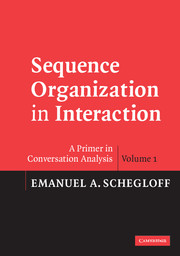Book contents
- Frontmatter
- Contents
- Preface
- Acknowledgments
- 1 Introduction to sequence organization
- 2 The adjacency pair as the unit for sequence construction
- 3 Minimal, two-turn adjacency pair sequences
- 4 Pre-expansion
- 5 The organization of preference/dispreference
- 6 Insert expansion
- 7 Post-expansion
- 8 Topic-proffering sequences: a distinctive adjacency pair sequence structure
- 9 Sequence-closing sequences
- 10 Sequences of sequences
- 11 Retro-sequences
- 12 Some variations in sequence organization
- 13 Sequence as practice
- 14 Summary and Applications
- Appendix 1 Conversation-analytic transcript symbols
- Appendix 2 Transcript of a telephone call
- References
- Index
9 - Sequence-closing sequences
Published online by Cambridge University Press: 05 September 2012
- Frontmatter
- Contents
- Preface
- Acknowledgments
- 1 Introduction to sequence organization
- 2 The adjacency pair as the unit for sequence construction
- 3 Minimal, two-turn adjacency pair sequences
- 4 Pre-expansion
- 5 The organization of preference/dispreference
- 6 Insert expansion
- 7 Post-expansion
- 8 Topic-proffering sequences: a distinctive adjacency pair sequence structure
- 9 Sequence-closing sequences
- 10 Sequences of sequences
- 11 Retro-sequences
- 12 Some variations in sequence organization
- 13 Sequence as practice
- 14 Summary and Applications
- Appendix 1 Conversation-analytic transcript symbols
- Appendix 2 Transcript of a telephone call
- References
- Index
Summary
As sequences get expanded, their structuring can become progressively less determinate. But this indeterminateness is not evenly distributed across a sequence's trajectory. Specifically, as sequences get expanded after their base second pair part, their structuring can become increasingly unconstrained. There are fairly straightforward reasons for this.
Pre-expansions are disciplined by the projected first pair part by reference to which they get their import. Their growth is always under the shadow of the parties' orientation to the sequence which the pre-expansion foreshadows.
Similarly, insert expansions are constrained by the relevant and impending base second pair part which has been made conditionally relevant by the base first pair part, a relevance which each element of insert expansion renews, as it defers its realization. The growth of insert expansions is under the shadow of the parties' orientation to the response to which they are preliminary.
However, post-expansions have no such projected structural component by which they are disciplined or constrained. Although some sequences do appear to require some third-position object to achieve closure (Jefferson and Schenkein, 1978), “third position” is a much less determinate position than second. The turn following a second pair part is a place ready for a third-position object to be recognized as such, as is the slot after a small post-expansion. But if there is a substantial expansion of the sequence after its base second pair part, then no next turn position can accommodate an “oh” or “okay” which will directly be recognized as closing the sequence.
- Type
- Chapter
- Information
- Sequence Organization in InteractionA Primer in Conversation Analysis, pp. 181 - 194Publisher: Cambridge University PressPrint publication year: 2007



